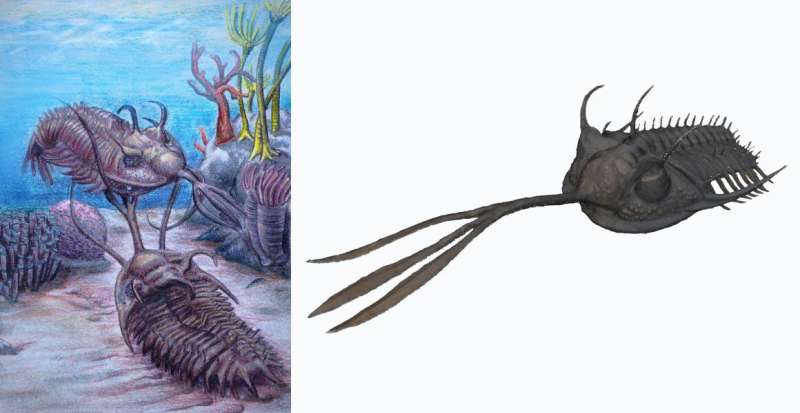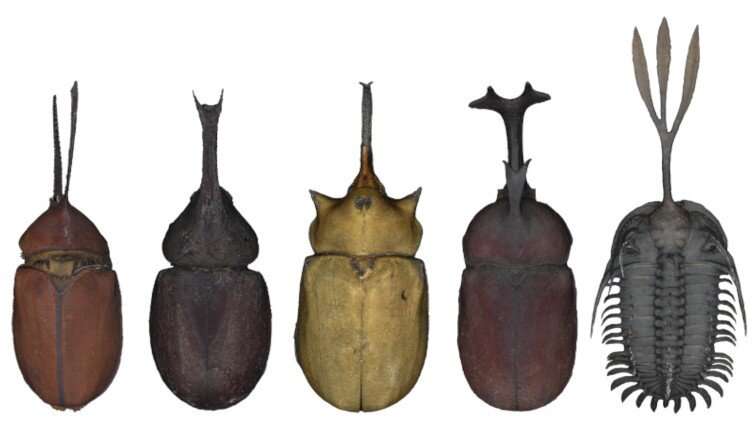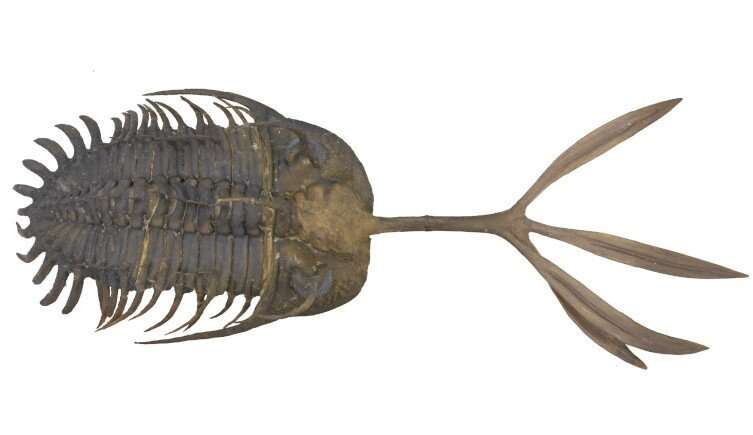This article has been reviewed according to Science X's editorial process and policies. Editors have highlighted the following attributes while ensuring the content's credibility:
fact-checked
peer-reviewed publication
trusted source
proofread
Unique trilobite trident could be the oldest evidence of male sexual combat

Fighting for mates may be a behavior that dates back over 400 million years.
A unique specimen suggests that male Walliserops trilobites fought each other using trident-like structures to win the opportunity to mate with females. So the history of jousting may go back much further than the Middle Ages.
A new paper, published in Proceedings of the National Academy of Sciences, suggests that a group of ancient invertebrates known as trilobites may have "jousted" hundreds of millions of years ago.
Trident-like structures found on the heads of Walliserops trilobites may have been used by males to compete in fights for dominance, with the arthropods trying to flip their rival over.
If confirmed, this could represent some of the oldest evidence of sexual competition and sexual selection ever discovered.
Co-author Professor Richard Fortey OBE FRS, who is a Scientific Associate at the Museum, says, "The extraordinary Devonian trilobite Walliserops carried a unique, giant trident on its head, the purpose of which has long been a mystery."
"We now believe that it was used for jousting between males striving for dominance. The evolution of sexually motivated competition in animals is hundreds of millions of years older than we thought."
The paper also speculates that these trilobites may have been sexually dimorphic, meaning males and females were different in appearance. However, the authors note that more evidence will be needed to conclude if this is the case.

What is sexual selection?
Sexual selection is an evolutionary process affecting characteristics associated with reproduction. It affects both primary sexual characteristics, such as the genitals, and secondary features that influence reproduction, such as the tail of male peacocks or the antlers of deer.
These secondary features are used to help attract mates and to compete with rivals and are some of the most obvious examples of sexual selection in the animal kingdom. In many species however, the impacts of sexual selection are much more subtle, and it becomes even more difficult to detect in extinct species.
While there is some evidence of sexual selection in dinosaurs, such as the frills of Protoceratops, there isn't enough evidence to rule out the other potential roles these structures had.
Making comparisons to living species, such as comparing the horns of the extinct Megaloceros to living deer, can be one way to try and avoid this. When structures are found in fossils, however, these comparisons can sometimes be problematic because it's not clear what feature of a living species they compare to.
Ever since Walliserops was described in 2001, it has been similarly difficult to understand the role of trilobite tridents. While a role in sexual selection has been considered, other roles in defense, burrowing or sensing food are also possible.
To make the extraordinary claim that the tridents have a role in sexual selection, the researchers needed extraordinary evidence. They believe they have now found it in the collections of the Houston Museum of Natural History.
The four-pointed trilobite trident
The trilobite at the center of this study stands out from many other Walliserops specimens held in museums because of its unique trident. Instead of having three points, or tines, it is the only known individual to have grown four. The tines are all broadly equivalent in size and there is no sign of injury, which suggests it was born with four as a result of genetic mutation.

Even more important than the four-tined trident itself is the fact that the specimen is fully grown. By making it to adulthood, it shows that the feature that makes it different from other trilobites didn't have a significant impact on its chances of survival.
This suggests that a role in feeding or digging is unlikely, because the changes the fourth tine causes to the overall shape of the trident would have made it more difficult to use for these purposes, limiting the individual's chance of survival.
It may have also influenced how likely the trilobite was to compete for mates, but the mating success of the individual, or lack thereof, would not have affected its survival chances. Deer with abnormal antlers, for instance, can still survive until they are fully grown.
While there are no characteristics of living animals that can be directly compared to the tridents of these trilobites, the striking weapons of rhinoceros beetles are broadly similar. These have large horns that can be as much as half of their body length and are used in fights between males during the mating season.
The researchers analyzed the shape of the Walliserops tridents and compared them to the weapons of beetles to try and understand how they might have been used. They found the trident shape was most similar to beetles that try to tip over their opponents with shovel-like weapons.
When the trilobites were alive 400 million years ago, it is believed they used their tridents to prod at each other before attempting to get underneath their rival and turn them over. While any trilobites that did get flipped were not necessarily stuck, the amount of time it could have taken to right themselves would have allowed victorious males the opportunity to mate with females.
It's possible that these females may have been trident-less if the trident is a sexually selected characteristic. In this case, females may have been inadvertently placed into a different group of species altogether, but this would be difficult to prove.
If the tridents are accepted as examples of sexually selected characters, they add to a growing body of evidence, such as the recent discovery of male claspers, which show that at least some trilobite species could be sexually dimorphic.
More information: Alan D. Gishlick et al, Trilobite tridents demonstrate sexual combat at 400 Mya, Proceedings of the National Academy of Sciences (2023). DOI: 10.1073/pnas.2119970120
Journal information: Proceedings of the National Academy of Sciences
Provided by Natural History Museum
This story is republished courtesy of Natural History Museum. Read the original story here




















